Recent Water Damage Posts
Staying Safe and Dry During a Flood | SERVPRO of Northwest Las Vegas
5/21/2024 (Permalink)
 Flash floods come at the most unexpected times. Are you dealing with the aftermath? SERVPRO of Northwest Las Vegas is here to help! Call us now.
Flash floods come at the most unexpected times. Are you dealing with the aftermath? SERVPRO of Northwest Las Vegas is here to help! Call us now.
We don’t see much rain around here on a regular basis, but when we do, flash flooding conditions can appear quickly. Our dry, arid ground can have a harder time absorbing a lot of rain in a short amount of time, and it can back up and start to flow down our streets and into our homes as a result.
Knowing what to do before, during and after a flood can help you navigate these disasters more smoothly. Let’s chat about some flood safety strategies below!
Preparation Tips
The best way to prevent serious damage from occurring is to prepare your home and property for the incoming rain. Cleaning up your yard and pulling children’s toys, yard equipment and any other clutter into your garage can prevent it all from being swept away.
You should also take the time to tie down patio furniture, propane tanks or grills that are too heavy to move but that could still be impacted by the flowing water.
Check on your gutters and downspouts to make sure they are clear and pointed away from your house, and then head inside to prepare your home. If you know that your basement floods often when it rains, move any fragile possessions or important documents up to a higher level and consider shutting off electricity down there for the time being.
Locate your emergency kit, and be sure you have at least one reliable way of receiving weather alerts that doesn’t require electricity to work.
When the Water Starts Flowing
If your home starts becoming infiltrated with water, try to stay calm and stay in a safe location. It can be scary to watch water seep into your basement or leak down your walls, but it is important to remember that the storm will eventually move on and the water will stop rushing in.
Once the storm passes on, be really careful moving about your house. Flowing water is really strong and could have caused damage to your home that you can’t see at the moment.
Wear sturdy boots and gloves if you have to walk through the water. Floodwater can be toxic or could be harboring sharp objects or chemicals, so try to stay out of it as much as you can. Now is the time to get us on the phone!
How We Can Assist You
Our team understands that water damage should be dealt with quickly and efficiently, so we will get started on your restoration as fast as possible. The longer the standing water sits in your home, the worse your damage could get and the risk for mold growth increases.
We will extract the standing water and use our thermal cameras to detect residual moisture. Once your space is dry, we can locate the source of the leak and address specialized repairs.
Water can easily warp floors, ruin carpet and create soggy walls, so we will also tackle these restoration jobs while we work. When we are done, your home will be dry and returned to its pre-flood condition.
Flood water can cause extensive damage. Contact SERVPRO of Northwest Las Vegas right away.
Where Is That Water Leak Coming From? | SERVPRO of Northwest Las Vegas
11/21/2023 (Permalink)
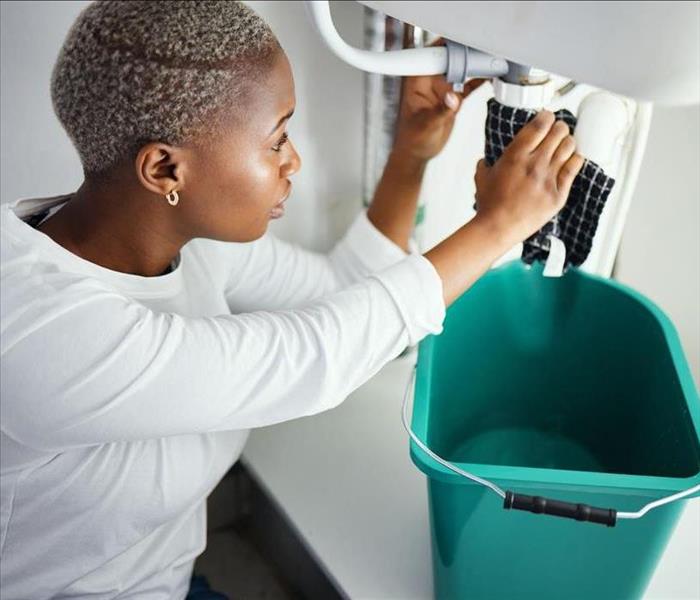 Has a leaky appliance left water damage to your home? SERVPRO of Northwest Las Vegas is here to restore your space. Contact us today!
Has a leaky appliance left water damage to your home? SERVPRO of Northwest Las Vegas is here to restore your space. Contact us today!
Water leaks can be really stubborn sometimes and can be hard to track down! One minute your home is running smoothly and you don’t have a care in the world, and then all of a sudden you are glancing up at your ceiling and notice a water spot or walk into your kitchen only for your socks to get soaked through.
A single dripping pipe or a malfunctioning appliance could be the culprit, but first you have to figure out where the water is coming from. Follow along as we explain some of the more common places for water leaks to occur and what to do when you do discover the source of the leak.
Where Water Leaks Often Start
A leak can start anywhere that you have water flowing through your home. Pipes are constantly moving water around behind your walls and a single worn water line or deteriorated seal can be enough for a serious leak to occur. Check the pipes and lines that are easily visible around your toilets, sinks and tubs for signs of moisture.
Another common location for leaks is around your appliances. We rely on our trusty appliances like dishwashers, washing machines and water heaters to help us get through our days, but they can also leak at any time and leave behind a water disaster, and probably dishes or clothes that are still dirty.
Checking your appliances regularly before you use them can help alert you to any developing situation, and you should also make sure you are performing any routine maintenance that can prevent these issues from actually occurring.
Controlling the Situation
If you have pinpointed the room or area of your house where the leak is originating, start opening cupboards, feeling walls and checking all water connections in the room. Once you locate the source of the leak, shut off the appropriate water valve to stop the flow of water and shut off the appliance at fault to ensure it can’t start back up again.
Once the situation is partially under control, it’s time to get us on the phone. Our team understands the time-sensitive nature of water disasters, and we will work quickly to prevent mildew or mold growth from taking hold. You should also take some pictures of any damage that you see.
The Drying Process
We will quickly identify the source of the leak and address repairs while also getting started on the water extraction process. We have industry-leading drying equipment that will pull water from every part of your space, including behind your walls or under your floor.
Once your space is clean and dry, we will tackle any water damage that was caused by the standing water. Water is known to warp wood, sag floors and ruin drywall, but we can help you recover from anything.
A fast water restoration can help you avoid mold growth and structural issues. Contact SERVPRO of Northwest Las Vegas today.
Pipe Break Plan
2/20/2023 (Permalink)
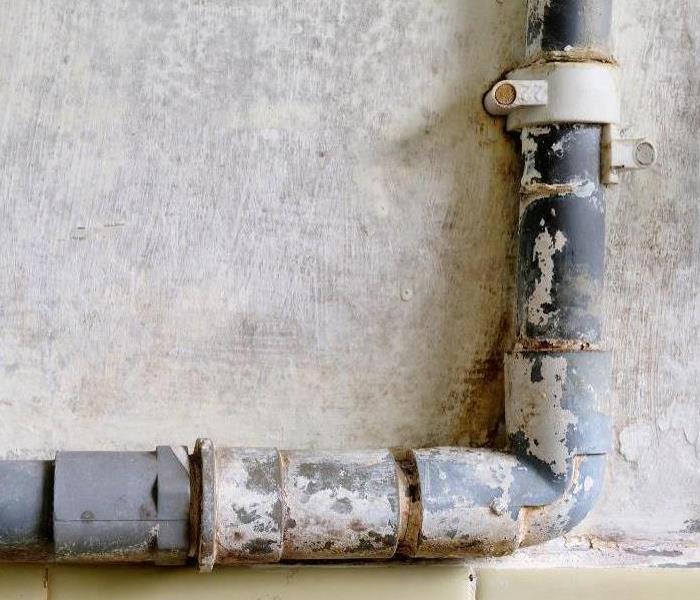 When water damage is present, give SERVPRO a call at the first sign of water damage.
When water damage is present, give SERVPRO a call at the first sign of water damage.
If your water pipe breaks, you have to do some quick thinking and action. Your first step should be calling your water service provider as soon as possible, but there are other steps you can take while you're waiting for them to arrive.
Call your water service provider.
The first thing you should do after a pipe has broken is call your water service provider. They will be able to tell you where the break occurred, as well as give an estimate for repairs. You can also ask if they have a 24 hour emergency service available and what it would cost to repair the pipe. In addition, ask them if they can provide temporary water supply until repairs are made or if there's another way around this problem (like getting access to another source).
Shut off the water supply to the broken pipe.
Shut off the water supply to the broken pipe. If you can't shut off the water supply, call your water service provider. Turn off the main valve. Turn off both handles on your faucet(s), then turn on another faucet in your house (to let air into pipes). After turning off the water supply open cabinets doors, under sinks or behind toilets until you find where your main valve is located.
Seal off the area to prevent further damage.
Seal off the area to prevent further damage. Use a wet/dry vacuum to remove excess water and a shop vac to suck up any remaining water in the pipe. Cover the area with plastic sheeting, then seal it with duct tape. This will help keep out airborne debris that could cause additional damage as well as protect your home from mold growth in case there's any moisture left behind inside of your walls or ceiling structure after everything has dried out completely
Remove any property that has been damaged by water.
Once you have identified the source of the leak, it's time to remove any property that has been damaged by water. Remove anything that is wet or has been damaged by water, including carpeting and drywall. Dry out the area as much as possible before removing anything else.
Remove any damaged items such as furniture or appliances and throw them out. If something is salvageable, put it in a safe place until repairs are complete. If there are spills on your flooring (such as food), clean them up immediately so they don't become permanent stains.
Water damage restoration professional
After a pipe break, the most important thing to do is get a water damage restoration company to clean up the mess. There are many things to consider when choosing a company and determining if they're right for your job. A good restoration company will offer a free estimate on how much it will cost to clean up your home or business after a flood or other water damage incident.
Experienced technicians who know what they're doing (and won't make any mistakes). It's tempting when hiring someone else because of how busy we all are these days--but remember that this is one area where saving money isn't worth risking quality results!
Give SERVPRO a call at the first sign of pipe break or water damage to your property. We are available to help 24/7 and provide experienced and knowledgeable technicians with the right equipment for any size water loss.
Is a Burst Pipe Covered by Insurance?
11/7/2022 (Permalink)
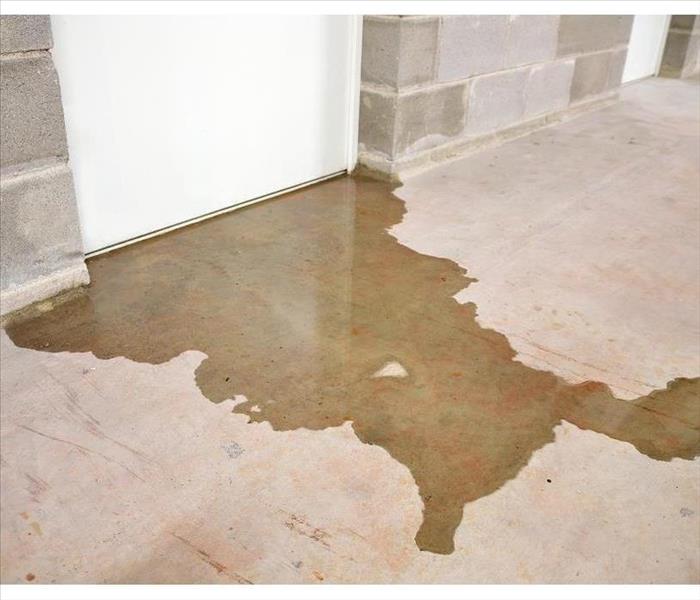 Leaks caused by poor maintenance are often easily spotted.
Leaks caused by poor maintenance are often easily spotted.
Help! A Pipe Burst in My Home!
If you've ever been the victim of a burst pipe, you know how devastating it can be. Not only is the damage expensive to repair, but also it can ruin your home's interior and lower its value as well as raise your insurance premiums. Sometimes water damage isn't covered by insurance at all! If you've found yourself in this situation or are worried about having pipes burst in the future, read on for answers to common questions regarding burst pipes and water damage.
Is a burst pipe covered by insurance?
If you have comprehensive insurance, a burst pipe may be covered by that. If you have a separate pipe insurance policy, it may be covered under that as well. Your homeowner's insurance policy could also cover the damage if you have one. If none of these are true for your situation then, unfortunately, the damage is likely not going to be covered by any type of insurance policy. In this case, it will fall on you to pay out of pocket for repairs or replacements when necessary.
Why do pipes burst?
The most common reason that a pipe burst is because it's old and worn. As pipes get older, they can become brittle and develop cracks that allow water to leak out of the system. Poor maintenance also causes leaks. Leaks caused by poor maintenance are often easily spotted, as they tend to be near where the pipe was installed or joined together. The only way to know for sure if your pipes are in good shape is to have them inspected regularly by a professional plumber.
A burst pipe can also be caused by external forces such as freezing temperatures or high pressure from nearby equipment like an irrigation pump or sprinkler system. Pipes made from copper often burst due to corrosion over time as well (corrosion is when minerals build up on your pipes). You may want to consider putting new plastic piping in areas prone to freezing temperatures if you live somewhere cold enough for them.
What do I do when a pipe in my home or business bursts?
If your pipe bursts, turn off the water. If you can't shut off the flow of water, try to contain it—this will help minimize damage to your home or other property. You should also call a professional plumber as soon as possible. In addition to being a plumber, you should call your insurance agent and SERVPRO of Northwest Vegas.
How much does it cost to fix a broken pipe?
The cost of repairing a broken pipe depends on many factors, including the size, location, and type of pipe. If the pipe is underground, it will be more expensive to repair than if it's above ground. The average cost of fixing a broken pipe is between $1,500 and $2,000. However, this figure can vary greatly depending on where you live and what kind of damage has been done to your home or business by the breakage.
We hope this article has given you a better understanding of how to handle the problem of a burst pipe. If you’ve been affected by water damage and are wondering if it’s covered by insurance, we encourage you to contact us today so we can help answer your questions and get started on making your Vegas, NV home safe again!
4 Steps To Create a Business Continuity Plan
6/16/2022 (Permalink)
 A business continuity plan is designed to help your business get through any situation in which normal business operations must be suspended.
A business continuity plan is designed to help your business get through any situation in which normal business operations must be suspended.
Four Steps To Create a Business Continuity Plan
Every new business in Northwest Las Vegas, NV, faces a myriad of risks that may lead to temporary stoppages in business operations. Common risks include natural disasters, fire, plumbing issues, and vandalism.
A business continuity plan is designed to help your business get through any situation in which normal business operations must be suspended. Here are the four main steps you must take to create a business continuity plan.
1. Perform a Business Impact Analysis
The impact analysis is designed to help you estimate how certain risks would impact important business functions. If you are not sure where to start, you can use a template questionnaire and have knowledgeable employees provide feedback.
2. Brainstorm Recovery Methods
The purpose of this step is to help you understand what would be necessary to recover successfully from the risks you have identified. You can conduct a survey of your current capabilities and how you could expand them.
3. Create an Emergency Response Plan
Develop a detailed plan for each scenario. Divide employees into teams with clearly defined responsibilities.
4. Develop Training and Testing Procedures
Create requirements for training and maintenance procedures. It is important that everyone in the company knows what their responsibilities are during an emergency. Assign someone to keep track of annual training schedules. Create drills and informational material that helps employees understand what their roles are.
Part of the plan development stage may involve familiarizing yourself with disaster cleanup services in your area. A professional restoration company with 24/7 availability will be able to help your business recover quickly and restore any property that can be saved.
To sum up, these four steps constitute a standardized model for business continuity plans:
- Business Impact Analysis
- Recovery
- Planning
- Testing
Planning for difficult events helps you secure the future of your business. You can move forward with confidence because you know you are ready to handle anything that comes your way.
Know Who To Call When Your Commercial Property Floods
3/19/2022 (Permalink)
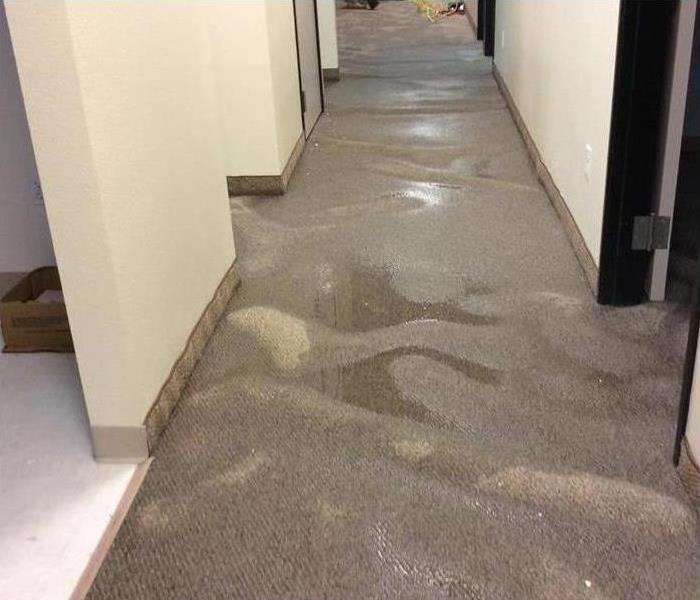 Flood from a storm in Medical District, NV.
Flood from a storm in Medical District, NV.
Know Who To Call When Your Commercial Property Floods
It’s the call no business owner wants to receive: “The building is flooded and there’s water everywhere!” Naturally, you may have many thoughts and questions going through your mind, such as who to call for water cleanup and how you can protect your property from water damage. The sooner you can get someone on the task, the better — the longer water sits or continues to flow, the greater the damage and cost.
Commercial Drying Specialist (CDS)
If the flooding is at all extensive, you need a commercial drying specialist who is an expert in the water cleanup process for commercial spaces. Commercial spaces are much more complicated and often larger than residential ones and require specific knowledge of the equipment, systems and variables that come into play.
The Remediation Process
IICRC certified specialists work according to industry standards, utilizing proven methods and the latest technology to create a total remediation strategy for your specific case.
Investigation: A broken pipe or damaged roofing might be obvious source of flooding, but sometimes the cause is hidden or multi-faceted. A CDS has extensive experience in knowing what to look for and where to find it, so nothing is left to chance and you decrease your risk of developing additional problems down the road.
Cleanup: Once the water is removed, your CDS will turn his or her focus to cleaning any carpets and fabrics and drying out electronics, equipment or electrical systems. Commercial floods can affect a multitude of areas, and certified specialists have the experience and training to address it all.
Preventative Measures: The CDS and remediation team will use highly specialized equipment to make sure the area is thoroughly dried out so you will not have a mold issue later on. They’ll also advise you about what steps you can take to prevent further damage in the future.
Know where you can find qualified specialists in your Medical District, NV, area before disaster strikes. Then if the unthinkable happens, you’ll know the first call you need to make for water cleanup and remediation.
Toilet Overflow? Here Are Your Next Steps
2/17/2022 (Permalink)
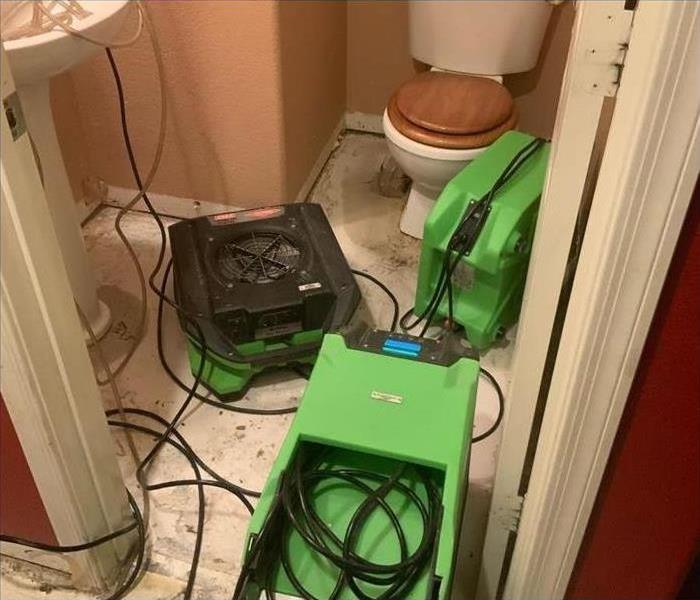 If you are facing problems with your toilet you should call in the professionals to clean up and resolve the flooding problem.
If you are facing problems with your toilet you should call in the professionals to clean up and resolve the flooding problem.
What To Do With a Toilet Overflow
If you face a flooded toilet merely by flushing, you may have sewer damage instead of a more surface-level problem. To mitigate the risk of damage to your bathroom floors and fix the overflow concerns, here is a list of steps to go through before calling a sewage company and water damage remediation specialists.
1. Stop the Overflow
Remove the lid of the toilet and lift the float. As you do this, ask someone else to shut off the water valve just behind the toilet. To do this, the other person will need to turn the valve clockwise.
2. Mop the Excess
Once the flooded toilet has stopped leaking, you can begin to mop up the excess water. You will also need to sanitize as thoroughly as possible. If it is a sewer damage problem, the water will be more dangerous than typical water that flows through the pipes in your home.
3. Plunge the Toilet
Plunging ensures that pipes are sufficiently cleared and that there’s no extra blockage about which you should be concerned. If plunging does not solve the issue, you will want to pay a phone call to your local sewage company.
4. Call for Professional Help
If you are certain that the water on hand is sewer water, it is crucial to call in the professionals. Your water restoration experts in Las Vegas, NV, will not only be able to solve water overflow issues, but they will also be able to examine and sanitize the affected areas – including floors, walls and baseboards – to make sure that the water leakage isn’t going to cause mold or health concerns.
If you are facing persistent flooded toilet issues or sewer damage, shutting off the water and calling the professionals to clean up can help you quickly resolve the flooding problem and any subsequent water damage.
Why Did Your Water Heater Spring a Leak After You Flushed It?
1/12/2022 (Permalink)
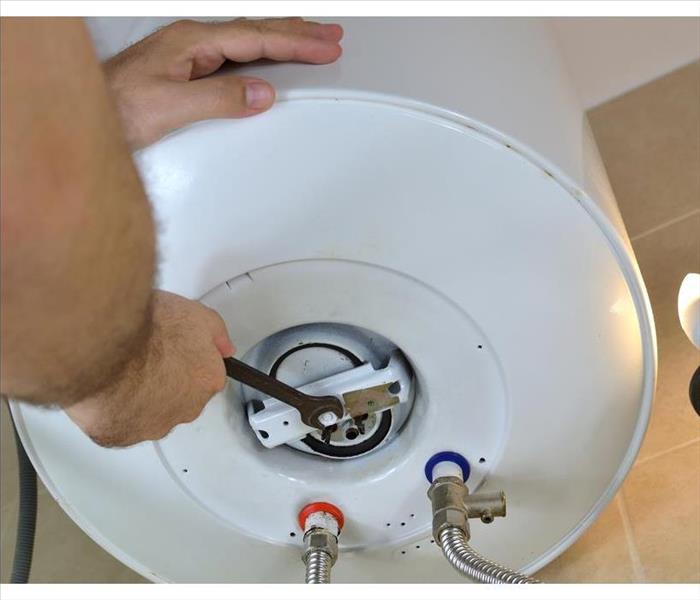 If you flush your tank every year or two, keep up the good work!
If you flush your tank every year or two, keep up the good work!
Flushing a Water Heater
You purchased your home in Northwest Las Vegas, NV, several years ago and recently ran across an article warning of the dangers of sediment building up over time in the bottom of your water heater. So, like any responsible homeowner, you decided to flush the tank on your next day off. Everything went according to plan, and after filling the tank with water, you left the area completely satisfied with your DIY skills.
A week after the water heater flush, you noticed the tank had sprung a leak. It was more of a slow drip, but it still consisted of water leaving the tank and ending up on your floor. What could have caused the new problem?
1. Sinking Sediment
As your heater ages, it can develop tiny cracks in the stressed metal casing. While the sediment at the bottom of the tank is certainly not a good thing, sometimes it can act as a plug for the miniature stress fractures in the metal.
2. Unclogging Holes
When the sediment is removed, the flushing water force can wash away the particles plugging the little holes, allowing the water to escape. Sadly, the size of the hole often determines the nature of the drip and how quickly you need to deal with the problem.
3. Dripping Heater
Once the leak develops, you may wish to contact a water removal specialist to determine what can be done. The professionals can help you determine how best to deal with a leak that is sure to expand over time as the tank ages.
If there is a moral to be had from this example, it is that a water heater that has not been flushed for many years should probably have the sediment removed cautiously by water professionals. On the other hand, if you flush your tank every year or two, keep up the good work!
 Flash floods come at the most unexpected times. Are you dealing with the aftermath? SERVPRO of Northwest Las Vegas is here to help! Call us now.
Flash floods come at the most unexpected times. Are you dealing with the aftermath? SERVPRO of Northwest Las Vegas is here to help! Call us now.





 24/7 Emergency Service
24/7 Emergency Service






